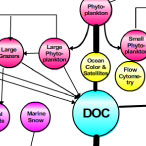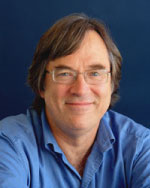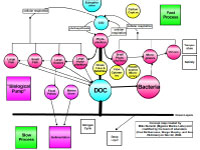Scientist Michael Sieracki explains the concept map and its development:
The challenge in concept mapping for me was to simplify my topic enough for the target audience (e.g., college
freshman with no marine science background), but also remain scientifically accurate. I chose to focus on an
oceanic process called the "biological pump", a component of the global carbon cycle that is included in all
ocean carbon models, but it is really a model itself. The biological pump represents how we believe that organisms,
microbial plankton in particular, can affect the flow of carbon in the ocean. To begin, I recalled first time I
saw the biological pump model, almost 20 years ago. Even though scientists have added details over time, it is
still a good general model upon which I have "mapped" my own research ideas.
I chose to divide my "For Educators" map into sectors divided by horizontal and vertical lines. Above the horizontal
line is the upper layer of the ocean that interacts directly with the atmosphere. Below this line is the deeper
ocean that doesn't interact directly with the atmosphere, except on very long time scales. The vertical line
represents a divide in the size of phytoplankton and how they affect carbon flow in the upper ocean. To the left
of the vertical line, large phytoplankton fuel the "traditional food web." To the right of the line, small
phytoplankton fuel the recently discovered "microbial loop" which includes micrograzers, bacteria, viruses and
DOC (Dissolved Organic Carbon).
On the right side of the map, I added two labels -- "Slow" and "Fast" -- to show that there are different speeds
for carbon to return to the atmosphere after uptake by marine biological organisms. The "Slow" path (left of
vertical line) represents carbon uptake and flow through the traditional food web. This includes biomass sinking
to the deep ocean - e.g., as "marine snow" or "fecal pellets" - where it will likely not return to the atmosphere
for a long time. The "slow process" has a net removal of carbon from the atmosphere - often described as carbon
being "pumped" down to the deeper layers. The "Fast" path (right of vertical line) represents carbon uptake and
flow through small phytoplankton and the microbial loop. This includes fast-growing microbes and quick respiration
of carbon dioxide that can remain in the upper ocean and eventually return to the atmosphere. It is believed that
this "fast process" results in no net removal of atmospheric carbon. My own research is focused on determining
the conditions that favor either of these pathways - i.e., traditional food web vs. the microbial loop -- and
how they affect, or are being affected by, climate change.
The workshop educators and I streamlined my original map, both in terms of vocabulary and linking lines. In
our "Group Final Map," we chose to keep the bold lines separating the ocean layers (horizontal) and sizes of
phytoplankton (vertical). We also added more detail to the food webs. We emphasized the important role of
dissolved organic carbon (DOC): just about all organisms produce DOC, some bacteria consume it, and its
production enhances the microbial loop. We added the concept of "sedimentation" but also agreed that - for high
school students -- it could be augmented by another concept map for "carbon sequestration" that would emphasize
sinking and burial.
|













